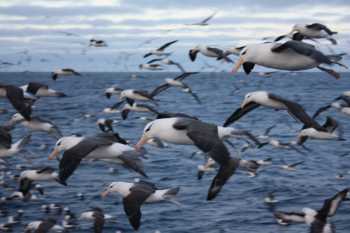Bronwyn Maree (Albatross Task Force, BirdLife South Africa, Cape Town, South Africa) and colleagues have published in the journal Animal Conservation on reductions in seabird mortality that occurs when trawl trail bird-scaring lines.
The paper’s abstract follows:
Globally, many thousands of seabirds are killed accidentally in demersal trawl fisheries through cable interactions and net entanglements. However, multi-year datasets for estimating seabird–trawl interactions robustly are scarce. In 2004/2005, an estimated 15 500 (7000–26 000) seabirds were killed annually through cable strikes in the South African deep-water hake trawl fishery; the majority were albatrosses. We reanalysed those data using fishing effort from vessel logbooks (previously unavailable). The new estimates are ∼40% lower across all taxa: ∼9300 birds in 2004, of which ∼7200 were albatrosses. We compare these figures to data from 2006 to 2010, when vessels used a single measure (bird-scaring lines) to reduce seabird mortality. From 64 trips and 690 hours of observation, 41 seabirds were confirmed killed due to cable strikes, of which 22% were albatrosses. Fatal cable interactions occurred overwhelmingly when vessels discarded offal, with the highest rates (birds killed per hour of observation) in winter and during setting. Comparing rates shows that bird-scaring lines alone resulted in 73–95% lower mortality in the winter/discard strata (all seabirds: 0.56 birds per hour before, 0.15 birds per hour after, P < 0.001; albatrosses: 0.44 birds per hour before, 0.02 birds per hour after, P < 0.001). Estimated total mortality [mean and 95% confidence intervals (CIs)] in this fishery in 2010 was 990 (556–1633) seabirds, including 83 (38–166) albatrosses, a reduction in mean albatross deaths of > 95%, reflecting both bird-scaring line effectiveness (accounting for > 90%) and annual fishing effort reduced by 50% from 2004–2005 to 2010. Bird-scaring lines cost < US$200 each in South Africa, a trivial expense per vessel for a measure that reduces fatal interactions with threatened seabirds so effectively. Our results provide a strong case for the mandatory adoption of bird-scaring lines in trawl fisheries with high densities of scavenging seabirds.”

Black-browed Albatrosses gather behind a South Atlantic trawler
Photograph by Graham Parker
Click here to find BLSA's press release on their recently published research on bird-scaring lines for trwalers.
With thanks to Bronwyn Maree for information.
Reference:
B.A. Maree, B.A., Wanless, R.M., Fairweather, T.P., Sullivan, B.J. & Yates, O. 2014. Significant reductions in mortality of threatened seabirds in a South African trawl fishery. Animal Conservation doi:10.1111/acv.12126.
John Cooper, ACAP Information Officer, 08 May 2014

 English
English  Français
Français  Español
Español